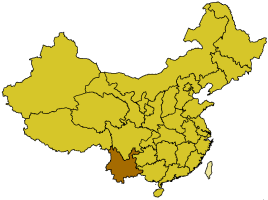| Revision as of 17:40, 9 August 2003 editJiang (talk | contribs)43,437 editsmNo edit summary← Previous edit | Revision as of 13:52, 24 October 2003 edit undoOlivier (talk | contribs)Administrators98,448 editsNo edit summaryNext edit → | ||
| Line 38: | Line 38: | ||
| == Demographics == | == Demographics == | ||
| Ethnic groups include: | |||
| * ] in ] | |||
| == Culture == | == Culture == | ||
Revision as of 13:52, 24 October 2003
Yunnan (云南, pinyin yun2 nan2) is a province of the People's Republic of China, located in the far southwestern corner of the country.
| Province Abbreviation(s): 滇 (dian1), 云 (yun2) | |
| Capital | Kunming (昆明) |
| Area - Total - % water | Ranked 7th 394,000 km² xx% |
| Population
- Density | Ranked 12th
109/km² |
| Administration Type | Province |
 | |
History
- 1894: George Ernest Morisson, an Australian correspondant for The Times, travelled from Beijing to British occupied Burma via Yunnan. His book An Australian in China details his experiences.
Geography
Yunnan is the most culturally and geographically varied province in China, with many minority peoples nestled throughout the region's mountains, jungles and river-valleys.
See also: Maotianshan shales
Rivers
Several major rivers flow through the province, including:
- the Mekong (澜沧江; lan2cang1jiang1), which empties in the South China Sea via Laos, Cambodia and Vietnam
- the Red River (元江; yuan2jiang1), which empties in the South China Sea via Hanoi, Vietnam
- Salween (怒江; nu4jiang1), which empties in the Andaman Sea via Burma.
Borders
Bordering provinces are Tibet, Sichuan, Guizhou and Guangxi. Bordering countries are Vietnam, Laos and Myanmar.
Economy
Demographics
Ethnic groups include:
Culture
One of Yunnan's famous products is Pu'er tea, named after the town of Pu'er.
Tourism
Tourist centres in Yunnan include Dali, the Naxi town of Lijiang, Zhongdian, The Stone Forest and Jinghong, Xishuangbanna.
The Old Town of Lijiang, is a UNESCO World Heritage Site since 1997.